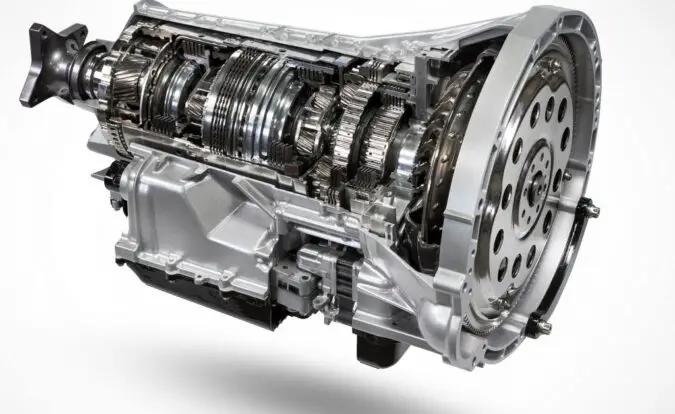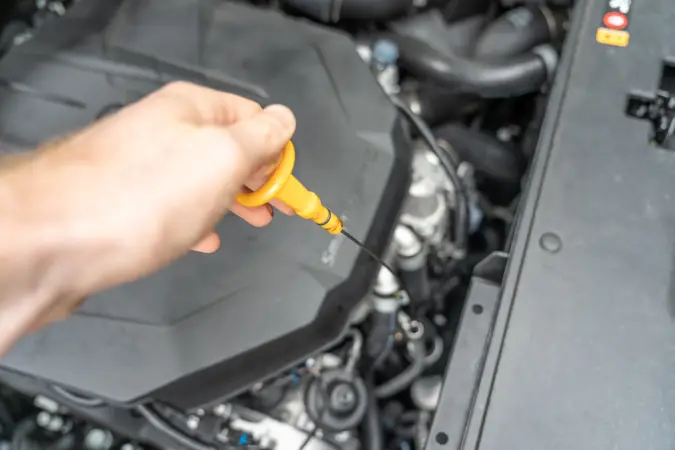Given the modern age of technological advancements, the need to maintain your technical gear to match the performance standard has become a crucial necessity. Although scientists and engineers are always on the lookout to create sustainable innovations such as ATF fluid that’s enough to last a lifetime, playing our part has no harm whatsoever.
One of these modern inventions that demand attention is vehicles. The car in your garage is one of the most well-regarded engineering masterpieces globally. Therefore, looking after the health of engines and overall physical appearance is a duty we all need to attend to. Hence, this is where ATF fluids come into play.
This blog will help cover everything you need to know about transmission fluids, steering fluids, fluid levels, etc.
- What Is ATF Fluid
- Transmission Fluid Types
- How Does It Work?
- Symptoms
- Fluid Change
- Benefits Of A Change
- Driving Without Fluids
- Power Steering Fluids Vs ATF
- FAQs
What Is ATF Fluid?
Automatic Transmission Fluid is an oil used for transmissions in vehicles. It is often distinguished by the color red or green so that people can identify the difference between them and regular motor oils. These fluids are optimized to meet the demands of transmissions, including brake band function, valve operation, torque converter, and act as an excellent lubricant.
Moreover, it can also act as a hydraulic fluid in various power steering systems covering significant automatic cars and transportation means. Furthermore, this fluid plays a significant role in keeping your car in top shape for increased performance. Often people confuse the two terms motor oil and transmission fluids and don’t understand how essential it is to keep an eye on changing your fluids. There are various types of transmission fluids depending upon the model and structure of your car. Down below are the types of fluids and their uses.
Transmission Fluid Types
In a general approach, there are two types of primary fluids; mainly automatic transmission fluid and manual fluid. Apart from this, you can also get familiar with synthetic transmission fluids and specialty fluids. Therefore, distinguishing the suitable fluid is crucial for car owners to keep their cars of top-notch quality and ensure the machinery works seamlessly.
1. Automatic Transmission Fluid
These fluids work best for cars that have an automatic transmission system. In simpler words, a car that doesn’t require a clutch and gear. However, it also serves the manual modern transmission cars. Some examples of this fluid are ATF +4 transmission fluid. Also, this fluid performs the following functions for your car;
- Clutch friction operation
- Brake band friction
- Torque converter operation
- Transmission cooling
- Gear lubrication
- Valve body operation
2. Manual Transmission Fluid
As the name suggests, manual transmission fluids work best for conventional vehicles and their manual system. These cars require more attention because of their gear and clutch boxes. These two functions help maintain the stability and speed of your car. Hence, the right lube or oil can determine the health of your car for an extended period. Additionally, it’s important to note that these cars cannot bear the burden of heavier oil due to their older versions, such as 75W to 140W.
In most cases, some conventional vehicles will also smoothly operate on automatic fluids. The execution largely depends upon the formula of the oil and how effectively it works on your behalf. You can always opt for ATF 3 transmission fluid if it calls for it.
3. Synthetic & Traditional Transmission Oil
As mentioned above, the real deal lies in the formula of oil. Therefore, it’s essential to know what these types of oil content are and how it makes them ideal for your choice of car. For example, a transmission fluid consists of crude oil while reshaping the hydrocarbons for the specifications of various transports. On the other hand, synthetic fluids include amalgamating different chemical reactions. Hence, making this oil a hassle to break down or oxidize quickly.
All in all, the clear answer to choosing between the two is neither black nor white. The best answer comes from the guidance given by your car manufacturer or company. First, however, consult a transmission specialist if you’re still in a daze about what to choose. Our suggestion would be an ATF +4 transmission fluid.
What Does A Transmission Fluid Look Like?
An automatic transmission fluid showcases a thinner consistency with a slight reddish hue than common motor oils. The color change aims to simplify the difference between other motor oils and transmission fluids running your car. Also, it assists car owners and automotive mechanics in spotting a leak.
How Does ATF Fluid Work?
According to the biggest names in the automotive industry, transmission fluids help lubricate the metals and bearings inside the gearbox of a manual car. It aids in preventing the system from grinding down as it moves along. On the contrary, the fluid only smears the moving parts in automatic vehicles. However, it still provides hydraulic pressure and enough friction to keep the internal parts operational. Moreover, the fluid helps keep the system in both manual and automatic vehicles refreshing.
For a car, the most strenuous task is to shift gears repeatedly (fun fact, go check out our guide on how to shift a motorcycle). Therefore, a fluid ensures the car can swiftly change gears without wearing down any parts. If we talk about the history of transmission fluids, it dates back to the earliest, after the automobile industry’s rise. Manual transmission of oil has played a significant role in keeping transportation worldwide in top shape. Later in 1940, the ATF fluid came into the picture and started serving automobiles and manual vehicles on a global level.
Signs That Your Car Needs An ATF Fluid Change
Drivers know every sound that comes out of their car. They know the verberations of their transport better than anyone else. However, the situation may be entirely different for a newbie car owner. It takes time, patience, and a lot of maintenance to recognize the condition of your car from just a sound. Hence, there are a few signs you should look out for that indicate that your car needs a transmission fluid change pronto. These signs include the following:
1. Difficulty Shifting Gears
Isn’t it frustrating whenever you hit the accelerator and feel the engine rev, but there’s no movement? Well, that’s because the transmission is stuck between gears. Drivers with a manual car will likely feel resistance during shifting. Hence having issues in shifting gear is a clear sign of low fluid presence.
2. Grinding Noise
Since the transmission fluid lubricates the internal parts of your vehicle, experiencing a continuous grinding sound while driving can be a clear sign as well. These sounds usually feel like parts grinding against each other whenever you try to shift gears.
3. Gear Slip
Another side effect of low transmission fluid is witnessing downshifting or higher speed while driving. This is because the gear starts changing the speed on the flipside while moving, resulting in a low fluid result.
4. Delay in Acceleration
Alongside this, whenever you press the accelerator for more speed and the car takes a few minutes before surging forward can also mean that your transmission needs flushing.
5. Unnecessary Surging
Suppose your car randomly starts lunging forward or backward without any reason. In that case, the sign is clear that your transmission system is contaminated and requires a proper change before they block the remaining system completely.
Important Note*
Please note that the signs mentioned above can also danger you when driving on highways. In addition, unnecessary surging and gear slips can aid in accidents when surrounded by speeding cars. So, make sure to maintain the regularity of changing transmission fluids to prevent any mishaps.
How Often Should You Change ATF Fluid?
Both automatic and manual fluid can get contaminated with dirt, debris, and particles with time. Although, you don’t need to change transmission fluids as often as motor oil. It’s crucial to watch for possible signs and regular checkups.
As discussed above, when the quantity of your transmission fluid is low, you’ll witness a notable change in performance when changing shifts due to damaging internal parts due to a lack of lubricant—most manufacturers consider the model of your car and its functionality. The average transmission change for a car can be around 30,000 to 60,000 miles.
Additional tips to consider are harsh weather conditions and towing heavy loads with go and drive lanes can also contribute to early fluid emptiness. Hence, if you live in such areas, it’s suggested that you pay close attention to your car for any signs.
Requirements For An Effective ATF Fluid?
A car is a vital part of our everyday life. It heals half of our workload from transportation hassles. Therefore, maintaining it to ensure it fulfills its duties ideally is an obligated chore. Hence, your fluid game needs to be robust to take on an automobile’s daily challenges. A suitable fluid satisfies the requirements of a car in an ideal way. Here are a few demands an ATF fluid should clear:
- Lubricating the gear and other parts of a gearbox.
- They are filling the torque converter to convey the power from the engine to the gearbox.
- The act of the hydraulic medium is to engage the signals from the valve in the control unit to internal brakes and clutches to increase performance.
- Guaranteeing a smooth shift from rapid power take-up from the clutches and brakes.
- Remove frictional heat and offer a cooling effect to the overall transmission system.
An ATF needs a high lubrication performance and a satisfactory level of oxidation stability to withstand an increased temperature in local regions. Whereas, for cool weather, a degree of fluidity is required to ensure smooth operations. An ATF should use all the above properties to sustain ideal performance rates through its fluid lifespan.
Benefits Of An ATF Fluid Change
Buying a car may seem fun and easy but maintaining it is what takes up all the energy. Most Americans love their car to death and consider it a part of the family. So, they pay attention to a handful of things in their car, for instance:
- Wear and tear of tires
- Air pressure in tires
- Coolant levels and replacement
- Motor oil replacement
- Air filter checks
However, as discussed above, the most overlooked component of a car is the transmission. A transmission oil change is mandatory with accurate time intervals, To maintain the optimum health of a car. Taking proper care of such components can prove beneficial for the longevity of your car’s health. Here are some of the advantages of transmission fluid.
1. Reduces Issues With The Transmission
Fluid change can prevent the cause of contaminated systems within the car’s engine. Also, with proper on-time warranty fluid change, the risks of any future issues are carefully dealt.
2. More Fuel- Efficiency
Regular fluid changing helps the engine revive and become more fuel-efficient. This activity helps the car run seamlessly on the roads and also aids in lower fuel consumption for long distances.
3. Engine Optimization At Its Best
Fresh fluid change adds life to the overall condition of a car. It keeps the vehicle well-lubricated and boosts the optimum health of the engine and efficiency.
4. Helps In Saving A Few Bucks
For those who don’t know, transmission replacement and repair are pretty expensive and might be as much as thousands of dollars. Therefore, a periodic transmission fluid change can help prevent the need to get a replacement. Also, it increases the lifespan, reduces the risks of future damage, and ensures long-term satisfaction for both the owners and the car.
5. Seamless Gear Shifts
If it isn’t evident by now, you should know the most significant advantage of transmission oil is enhancing the gear shift function. It eliminates old oil with dirt and cleans the gearbox by offering a fresh source of oil.
What Happens If Your Car Runs Out Of ATF Fluid Completely?
We sincerely hope that never happens because it goes into a permanent gear lock when a car runs out of transmission oil. Your car won’t move because you can’t shift gear. Also, if you prolong the process of changing fluids, it’ll most likely damage the internal parts of your car.
As a result, you’ll have to spend a fortune on getting a new transmission system installed, fixed, and renewed. Hence, making a hole in your pockets. This type of scenario will most likely occur in an automatic car rather than a manual one. Overall, it’s crucial to keep an eye out for the signs so you don’t end up at the doorsteps of a professional auto mechanic.
Repair
Before completely changing your transmission system, get help from a professional to fish out any other issues within the vehicle. It helps to get the job done without paying a large sum of money altogether. One of the alternatives for repairing is transmission flush.
A transmission flush is a comprehensive method of cleaning the system by flushing out contaminations and other dirt. Firstly, the mechanic changes the old oil and, in return, adds the new oil and some cleansing solutions (if the need arises) to the system. Lastly, new oil is added to the system to freshen the car.
Transmission Technology
At the start of this blog, we mentioned how rapidly the world is evolving in the technological sector, especially the engineering and scientific industries. Such innovative and futuristic cars use the new IMT technology (Intelligent Manual Transmission).
These cars are not tied down with gearboxes and transmission systems. Instead, they offer owners the convenience of an entirely hybrid and automatic car. In simpler words, this technology eliminates the hassle of shifting gears repeatedly.
However, it’s believed that manual transmission car production may stop permanently with time. Hence, more and more auto companies are wheeling towards new technologies to renew their brands and customers simultaneously.
Transmission Maintenance & Services
We all know the struggles of life. The urgency to get up and go whenever the situation demands it; however, what happens when in the middle of such chaos, you stand wondering, “Is my car eligible enough for this distance?” Vehicle transmission maintenance and services is an essential tasks to save yourself from such frustrating times.
Transmission service holds utmost importance, especially regarding operating and performance levels. An outdated system may compromise your car and even put you in grave danger on the road. The best solution is to hand over your car to a professional auto mechanic who knows his way around the parts to prevent such things from happening.
Or better yet, entrust it to someone already familiar with your car’s previous conditions and who knows how to handle the situation perfectly. However, you should know the process of transmission maintenance and services as well. Firstly the car goes through a multi-check inspection, followed by road tests, system checks, and fluid change. So, the next time you take your car for an inspection, observe all the steps yourself.
ATF Power Steering Fluid
The debate between power steering fluid vs ATF has long been a subject of heated argument among car owners. Also, many newbies confuse the two terms and other motor oil and let their car pay the price. Everyone wants to know what the main difference consists of and whether these two oils are the same. Let’s carry on to clear your doubts once and for all.
Firstly, it’s essential to understand the definition of these fluids and figure out their primary purpose. ATF fluid helps clean, lubricate, and provide cooling to the transmission system while also engaging the signals from the gearbox to the clutches and brake components. While on the contrary, power steering fluids focus on lubricating the steering system steals.
Also, it helps spread the required hydraulic pressure when power steering with plenty of features present in the formula, including the correct power steering fluid such as Dexron ATF power steering fluid, Mercon ATF power steering fluid, ATF 4 power steering fluid, etc. Finally, these fluids are ideal when it comes to dealing with leakage. Leakage is a central issue often found with power steering steals. In comparison, the main focus with transmissions is problems in gear shifting.
Friction Modifications & Detergents
Although both these fluids are hydraulic, the key variants are friction modification and detergents. The detergent aids in cleaning the system of any greases and dirt particles, while the friction modifications ensure the pump’s check and prevent heat build-up inside the car. Numerous companies are now starting to mix the two fluids to perform their tasks simultaneously for both transmission and power steering. It’s up to you to keep an eye out for the correct oil to accommodate your car perfectly.
We hope this blog helped clear everything and describe ATF fluid in simpler words for everyone to understand. We’ve covered almost everything you could need to know regarding the fluid, cars, and services.
Transmission Fluid Facts: What You Need to Know
- Transmission fluid lubricates the bearings and metal parts inside a car’s manual gearbox and keeps them from grinding down as they move.
- There are two main types of transmission fluids: automatic transmission fluid and manual transmission fluid, and several different types and qualities of transmission fluid.
- Automatic transmission fluid is designed for cars that have automatic transmissions, while manual transmission fluid is typically used in older manual transmission cars.
- Synthetic transmission fluid is less likely to break down, oxidize or thin out in high temperatures than traditional transmission fluid.
- Transmission fluid levels should be checked regularly (and if so, learn how to remove too much transmission fluid), and manufacturers recommend changing your transmission fluid every 30,000-60,000 miles.
- Symptoms of low transmission fluid include transmission overheating, color changes, puddles, roaring sounds, chattering, warning lights, difficulties when shifting, and burning smells.
- If a car runs out of transmission fluid completely, it will most likely not go into gear, barely move or not shift at all.
- A transmission flush is a maintenance process that removes all of the old, dirty fluid in a transmission and replaces it with new clean fluid.
- Replacing old transmission fluid with fresh fluid and replacing the filter can help to prolong the life of your transmission and prevent issues before they happen.
- Always refer to the recommendations provided by your manufacturer for the frequency of changing your fluid or having a transmission flush.
FAQs On ATF Fluids
Here are some popular FAQs:
Can You Use ATF For Power Steering Fluid
In some cases, yes, you can. However, mainly when it comes to power steering fluids, they are specifically designed to accommodate the power steering in the best way. So, it’s better to use a power steering for the job rather than depending upon ATF. Some of these are Dexron and Mercon.
Can I Put ATF Transmission Fluid In My Power Steering
Yes, absolutely! You can opt for an ATF fluid for your power steering pump as a substitute. Both ATF and power steering fluid are hydraulic to perform well for the car at times.
What Is ATF Fluid
ATF fluid is an automatic transmission fluid that carefully lubricates your entire transmission system. However, ATF 4 is a synthetic fluid made for finely-tuned transmissions. Car wonders can use ATF 4 in appliances that demand older Dexron or Mercon fluids.
What Color Is An ATF Fluid
If fluid comes in a red, green, and sometimes purple or amber color. The colors are used to differentiate between other motor oils.
What Is The Best ATF 4 Transmission Fluid
There are many fluids available in the market. However, we suggest opting for Mopar ATF 4 transmission fluid for the best results and performance in your vehicle.
How To Check Fluid Level
To check your vehicle’s fluid level, carefully re-enact these steps. First, park your vehicle in neutral. Then, look for the transmission dipstick; this is often located near the rear of the transmission and engine. Next, remove the dipstick, clean and wipe it thoroughly (Caution; Fluid May Be Hot), reinsert it again, and then pull it out. Now, observe the markings on the stick; A dipstick generally has two markings for full; one warm and one cold. Finally, if the fluid doesn’t reach the warm mark, you need to add transmission fluid to your vehicle.
What Is ATF Power Steering Fluid
ATF power steering fluid consists of a pinkish fluid that helps lubricate the power steering system of a car, so the control over your steering wheel is effortless and precise.




